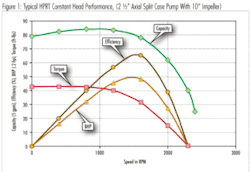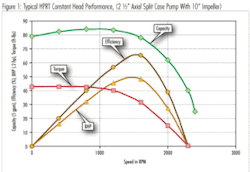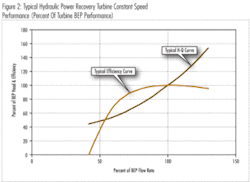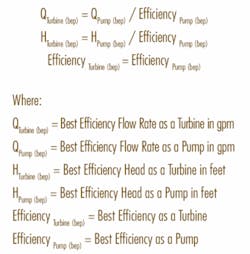Using Pumps As Power Recovery Turbines
By Allan R. Budris
Because of the present need to conserve energy, energy users must take advantage of every opportunity to reduce power requirements.
While wind and solar power are getting most of the hype due to green energy being such a hot topic these days, hydropower, the biggest and oldest source of renewable energy in the world, is getting another look in less obvious areas. Hydropower, which works by converting the energy of flowing water into electricity, is usually associated with big dams. However, proponents say it could also work if done on a small scale, and with enough small-scale hydropower installations it could add up to a significant amount of energy. By 2005, hydroelectricity accounted for about 19 percent of the world’s energy, and about 7 percent to 12 percent of the electricity in the United States. Further, as the cost of electricity rises and the price of fuel goes up the desire for this environmentally friendly energy source will increase.
Most centrifugal pumps can be run in reverse as hydraulic turbines. A good centrifugal pump operating with high efficiency may be expected to display good performance and reliability when the direction of flow is reversed and the pump is used as a driver. As a result, pumping equipment needed to satisfy the requirements of small-hydropower users is readily available, unlike conventional turbines. Besides being readily available, pumps are also less complex than conventional turbines and more flexible. They can be mounted vertically or horizontally, wet pit, dry pit, and even submersible. They can attain similar efficiencies to conventional turbines, and of prime importance to the small-site owner, they are normally less expensive and easier to justify. Spare parts availability and shorter production lead times are also advantages for pumps.
The basic hydraulic behavior of centrifugal pumps operating as hydraulic power recovery turbines (HPRT) is not much different from that of a pump, following the same sort of affinity laws over narrow ranges. In most instances, no design changes or modifications are needed for a pump to operate as a turbine. The following simple relationships can be used to approximate the turbine best efficiency head, flow rate and efficiency based on the known performance of the same unit operating as a pump, even though no simple theoretical method has yet been established to accurately predict turbine performance, short of actual testing.
The pump manufacture should be contacted to obtain the actual performance of a particular pump operating as a HPRT. When a selection is made, a design review is also required, because when operating as a turbine the rotation is reversed and the operating heads, flow rates and power output are higher as noted above. Consequently, a design review should include items such as:
- Check that threaded shaft components cannot loosen.
- Evaluate the adequacy of the bearing design
- Shaft stress analysis.
- Checking the effect of increased pressure forces.
Hydraulic power recovery turbine performance can be presented in the form of either a constant head graph, as shown in figure 1, or a constant speed curve, as shown in figure 2. Of these two formants, constant speed curves are more common and readily accepted, since many recovery turbines are operated in tandem with a steam turbine or electric motor, which holds the recovery turbine speed constant.
Figure 1 illustrates the variation of head-capacity, efficiency, brake horsepower and torque with speed for a typical power recovery turbine operating in a constant head system. Note that the torque available from the turbine reduces to zero at approximately 146 percent of the design speed. This ratio will vary from 125 to 170 percent, depending on the pump. Thus, for mechanical considerations, a power-recovery turbine is not analogous to a steam turbine, or variable inlet vane conventional hydraulic turbine, in that elaborate over-speed trip devises may not be necessary.
From the hydraulic power recovery turbine constant speed graph (figure 2), it can be noted that the head-capacity curve is an exact opposite to what would be expected in a centrifugal pump, with the turbine shut-off head being approximately half the shut-off value obtained for the same unit operating as a pump. Also, it should be noted that the output power (bhp), and therefore the efficiency, are zero at approximately 40 - 42 percent of the turbine best efficiency flow rate. Energy must be added to the hydraulic turbine in order for it to rotate (at constant speed) at flow rates below this capacity. It is for this reason that hydraulic power recovery turbines tend to be selected to operate near or above the turbine best efficiency point (bep), and that knowledge of the actual turbine best efficiency flow rate is critical. Conventional variable inlet vane hydraulic turbines have a definite advantage over HPRT units below the bep, since the power developed by conventional turbines does not fall off nearly as fast toward shut-off. Changes in casing nozzle throat size are the most effective way to change the performance of a HPRT. Changes in pump speed or impeller diameter are much less effective ways to change HPRT head or output horsepower.
In order to develop the approximate constant speed performance of a pump operating as a turbine, figure 2 can be coupled with the formulas above, which estimate the turbine best efficiency head, flow rate and efficiency. This can help with the initial pump selection.
In addition to using pumps operated in reverse to recover power from small water falls, or in place of throttle valves, HPRT’s can be used in bypass flow control lines. An attractive applications for a HPRT would be in the bypass line of the “Hybrid Control System” outlined in the authors August 2008 column. This would make the Hybrid Control System even more efficient when the system flow demand is low. WW
About the Author:
Allan R. Budris, P.E., is an independent consulting engineer who specializes in training, failure analysis, troubleshooting, reliability, efficiency audits and litigation support on pumps and pumping systems. With offices in Washington, NJ, he can be contacted via e-mail at [email protected].




